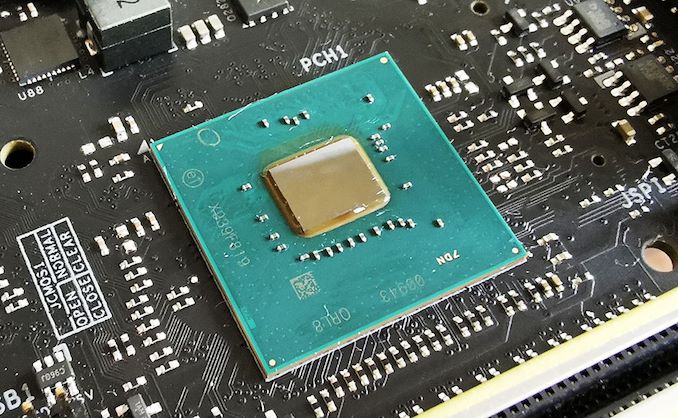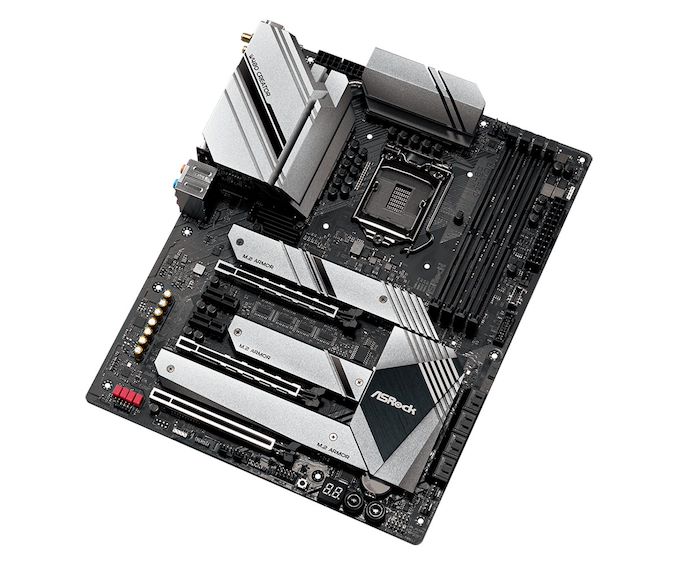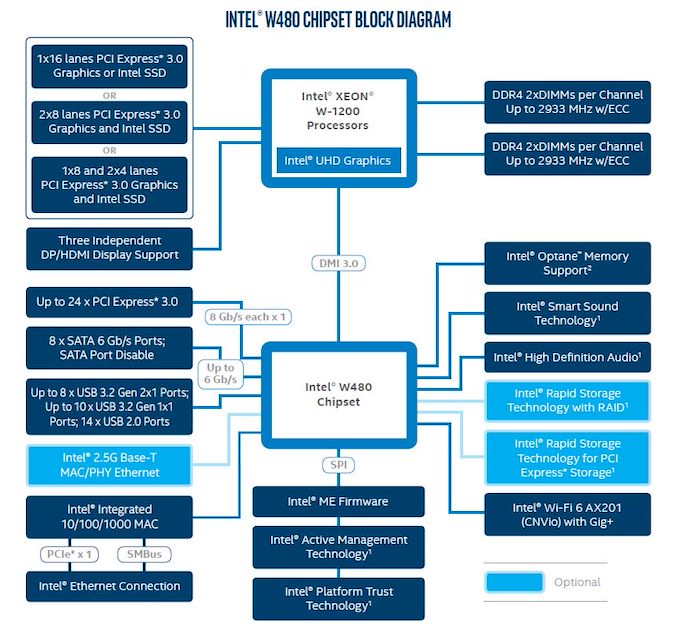The Intel W480 Motherboard Overview: LGA1200 For Xeon W-1200
by Gavin Bonshor on June 24, 2020 9:00 AM EST
During Intel's unveiling of the Z490 chipset and Intel Core 10th generation Comet Lake processors, Intel also announced its series of Xeon W-1200 processors. To accompany this announcement, without much fanfare, Intel also launched the W480 chipset which also features an LGA1200 socket. Aiming for a more professional feel for processors with ECC support, vendors have announced a variety of W480 models. Some target content creators, and others for workstation environments. These boards are paired solely with W-1200, and support both ECC and non-ECC DDR4 memory.
The Intel W480 Chipset: For Xeon W-1200
The primary differences between the consumer and generally gaming-focused Z490 models and the W480 aren't as staggering one might think on paper. The difference is more product segmentation than anything else. W480 includes the key technologies which Intel has put into Comet Lake. Some of the notable technologies on Intel's Xeon W-1200 series processors include Turbo Boost Max 3.0 which boosts a single core far, and beyond the overall base frequency, e.g. the Intel Xeon W-1290P which is the top SKU has a base frequency of 3.7 GHz, with a maximum Thermal Velocity Boost single-core speed of up to 5.3 GHz. The P in the Xeon W-1200 series stands for performance, with a rated TDP of 125 W, with all of the product stack featuring support for up to 128 GB of DDR4-2933 ECC memory.
The Intel W480 chipset layout is identical to Z490. Some of the integrated features include up to 24 PCIe lanes, with some features optional and some as standard, with support for up to eight SATA ports, and allows vendors to choose which kind of USB connectivity is used dependant on model. I support for up to eight USB 3.2 G2 ports, with a maximum of ten USB 3.2 G1 ports, and fourteen USB 2.0 ports, although it has to be selective in the number of USB ports it uses, as each array uses a different amount of PCIe.
Intel has stuck with the 2.5 G Base-T MAC which allows vendors to easily add 2.5 GbE Ethernet controllers if they wish to do so. At the same time, it also allows the manufacturers to utilize Intel Rapid Storage technologies. Intel also includes an integrated Intel Wi-Fi 6 CNVi which will enable users to integrate a wireless interface up to and including an Intel AX201, which of course involves a higher cost which is passed onto the end-user. The most significant aspect to consider between W480 and Z490 is that W480 has official support for ECC memory, with up to 128 GB allowable in terms of capacity. Some of the older generations of Intel platforms from yesteryear has allowed cross-use between its Xeon E3-1200 series processors on its desktop chipsets, although Intel has completely segmented away the Xeon W-1200 range, so Xeon W-1200 is supported on W480 only.
Intel W480: Small Stack, Big Models
While vendors weren't clamouring over themselves to unveil its W480 models during the initial announcement of W480 and Intel's Xeon W-1200 processors, the cat is out of the bag so to speak. At present, we've only been able to find ten models across six vendors in total at the time of writing, which isn't a large product stack. We do expect more models to be announced at a later date, but at present, it's anyone's guess as to who or what will be unveiled further down the line. Some of the vendors have stated that their products aren't really going to retail, and will end up mostly in the hands of system integrators who build these systems for their clients.

The ASRock W480 Creator Motherboard
Focusing on the product stack, ASRock, ASRock Rack, ASUS, DFI, GIGABYTE, and Supermicro have announced some models. There's a mixture of ATX and micro-ATX. Some of the most premium models come from the big four vendors in terms of design, aesthetics and feature sets, with the stand out models including the premium ASRock W480 Creator. As the 'Creator' name suggests, it is targeting content creators with its dual Thunderbolt 3 Type-C rear panel connectivity, triple PCIe 3.0 x4 M.2 slots, and eight SATA ports. Another comes from GIGABYTE via the W480 Vision D, which has an exquisite white and black contrasting design and is resembles the former Designare range. Included in the W480 Vision D's feature set is Thunderbolt 3, triple PCIe 3.0 x4 M.2, and eight SATA ports, six of which include support for RAID 0, 1, 5, and 10, while the additional two ports come via an ASMedia SATA controller.
Another inclusion across the majority of the product stack is three or more USB 3.2 G2 rear panel connectivity, which is using Intel's W480 to its capabilities. One exciting example of this is the ASUS Pro WS W480-Ace with dual Thunderbolt 3 Type-C with a pair of DisplayPort inputs, with four USB 3.2 G2 Type-A ports for an impressive rear panel. No fewer than six of the ten W480 models incorporates three or more USB 3.2 G2 on the rear panel, including the trio of Supermicro models, the micro-ATX X12SCZ-TLN4F and X12SCZ-F, with the ATX X12SAE.
Motherboards Covered in This Overview
For quick links to each of the pages for each of the models covered in this W480 overview:











38 Comments
View All Comments
duploxxx - Thursday, June 25, 2020 - link
Intel don't need to compete with threadripper. This workstation chipset will move to all default OEM workstations as usual. OEM that are affraid to change anything on there portfolio because of R&D funding budgets from Intel to keep using there chipsets and cpu. IT will swallow it anyhow as they see still Intel as the only fit for business.... and also because the decision body is most of the time led by people who are sitting far to long at an IT desk thinking they still know anything about HW. 100000's of these workstations will just be business as usual, CVE, underwhelming core performance vs competition, heat, it does not matter the only thing OEM (Dell, HPinc, ...) will offer are Intel based workstation. We use 1000's a year asking several years to get an alternative into the Z offering from HPinc to getdecent pricing on +10 cores …. the only answer is "we will look into it"Dr_b_ - Monday, September 21, 2020 - link
"This doesn't even compete with Threadripper, much less Epyc."Its not trying to. TR and EPYC are in a different cost tier entirely. Why would you buy a TR or EPYC and pay more, if you didn't need the number of cores or lanes they offered, and if your workloads weren't going to utilize those cores or lanes. And if you needed those cores and lanes, you wouldn't be looking at this segment. Think edge computing tasks, SMB, storage, virtualization.
Intel also offers stability, and an IPC advantage, at least for now. Maybe ZEN3 comes along and changes the game, at least in terms of IPC, but the jury is still out on stability. Poor QA, insufficient testing and qualification, and really bad software, seems to be a systemic issue at AMD.
edzieba - Wednesday, June 24, 2020 - link
Different use-cases. If you buy a workstation with the attitude of "more cores must be more better!" you will very likely end up wasting money on a system that does not perform as well as one chosen for the tasks you will be performing.Deicidium369 - Wednesday, June 24, 2020 - link
Most people who opt for this board will use it as a small office server - and most would not even need to expand. Add a couple sticks of ECC or not memory, a couple of SATA drive and they would be set. several USB3.2 ports, 2.5Gb/s Ethernet and integrated graphics. Perfect small business server.MDD1963 - Saturday, June 27, 2020 - link
had a person on a forum tentatively planning on using an X299/ i9-7900X as the basis for a simple home media/file server build....(undoubtedly on a 1 GbE network at home, no less)Samus - Wednesday, June 24, 2020 - link
I think the lack of PCIe 4.0 is the sole deal breaker. Intel has it on their high end server platforms, why hasn't this filtered down to the workstation...you'd think they would just tweak the same chipset - the silicon support IS THERE in Comet Lake CPU's as they have already announced Rocket Lake (the same microarchitecture as Comet Lake) will support PCIe 4.0 later this year. I mean what is that going to require yet another chipset?Two totally different platform launched in the same year, really Intel?
Deicidium369 - Wednesday, June 24, 2020 - link
Vast majority of small businesses who would opt for this CPU could care less about PCIe4 or more cores.Rocket Lake S will be built on the same process as Comet Lake - but will be basically a Tiger Lake in architecture (Willow Cove, Xe LP 24EU). Z490 will support PCIe4 on some boards - but Rocket Lake will launch with the Z590 which will be PCIe4. Will be great to finally have PCIe4 reach mainstream status. Same LGA1200 socket, different chipsets.
Samus - Wednesday, June 24, 2020 - link
You are joking right? Why would somebody buy a high end workstation in June 2020 with PCIe 3.0, when PCIe 4.0 SSD's have been out for months and even the PlayStation 5, a VIDEOGAME CONSOLE, will have a PCIe 4.0 SSD next year, all the while Intel will be revising these CPU's and presumably the chipset around PCIe 4.0 within 6 months?Anybody buying into this platform is getting screwed. To say someone who wants a W1200 doesn't care about PCIe 4.0 is as ridiculous as saying someone who buys a Corvette doesn't care about 0-60.
PixyMisa - Wednesday, June 24, 2020 - link
Intel themselves are selling PCIe 4.0 SSDs. They just don't have anything that can use them at that speed.Foeketijn - Thursday, June 25, 2020 - link
No. These servers are the cheapest servers. That is the sole purpose. You want high end? You need a different platform. Box from the shelve. Install Windows server. Done.No upgrades, no performance parts. Just run it as long as it runs.